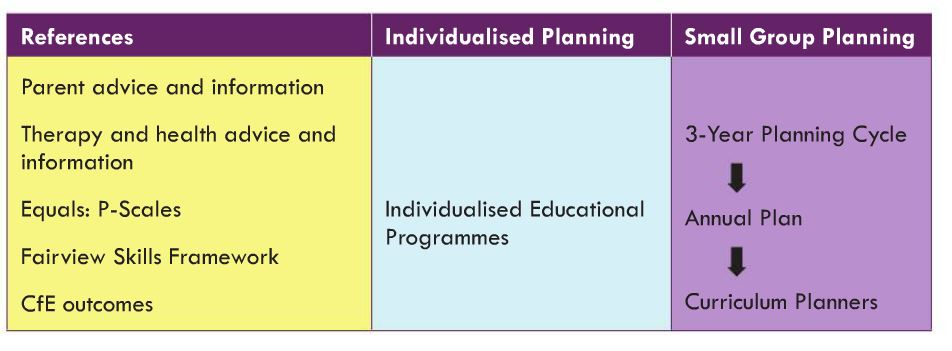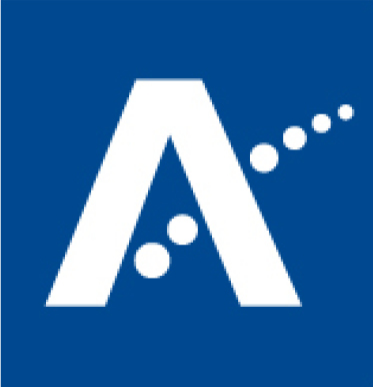9. The School’s Approach to Identifying, Assessing and Planning Pupils’ Needs
Staff asked their next critical question:
‘How should we identify, assess and plan for the needs of our children and young people?’
In so far as
identification and assessment is concerned, they agreed that they should be able to:
- use relevant resources to identify developmental levels. These include pupil profiles of prior learning shown here: Routes for Learning materials (Prerequisites for Literacy and Word Levels)(4*), EQUALS materials (P Scales)(5*) and developmental milestone information gained through in-service training by the occupational therapist;
- use information gathered through discussions with Speech & Language Therapists;
- liaise with parents to agree protocols for intimate care, moving and handling, eating and drinking, swimming, rebound therapy and residence programmes;
- use ASDAN Levels (of support) and SQA performance criteria;
- identify skills development levels of learners, described in the school as: ‘encountering’, ‘experiencing’ and ‘learning about’;
- use P-Scales (6*) and the school’s Skills Framework, which are explained in the following links: Primary Skills; Secondary skills; skills bank 1, 2& 3 and pupil skills profile to support teachers’ professional judgment to determine each pupil’s level;
- use Equals Pace materials (7*) as formative assessment in order to ensure sufficient challenge along with suitable level of support;
- use a range of assessment approaches to evaluate learners’ achievement and progress using: say-write-make-do, in response to children’s learning experiences in a range of contexts within and outwith school;
- record achievement and progress in a range of ways using photographs, adult observation statements, presentations from learners – what they communicate, make, do and write or draw, and move to e-profiling;
- track learners’ progress within IEP targets using the class tracker proforma;
- use the evidence from the class tracker proforma to support senior managers’ confidence that IEPs are at the appropriate level;
- benefit from visits and observations by senior managers and peers in their classrooms;
- collate evidence of achievement and progress in IEP evaluations, skills profiles, log books, ASDAN and SQA folders;
- participate in moderation processes with colleagues, and senior managers as required .
In so far as
Planning is concerned, teachers agreed that they should be able to:
- consult with all relevant staff and parents and use suitable materials to support the development of targets in literacy, Numeracy and Health and Wellbeing within IEPs, including using the planning discussion proformas:
Planning Discussion Proforma 1
Planning Discussion Proforma 2
- create an annual plan which takes account of the whole school cycles and the specific needs of the class or small group shown here
- consider relevant teaching contexts to enable learners to demonstrate and teachers to judge progress within literacy, numeracy and health and wellbeing skills within IEP targets and curriculum planners.
- use the curriculum planners to:
- create relevant, exciting and stimulating tasks and activities for learners which enable them to develop identified skills;
- enable pro-active and responsive use of assessment;
- assess learners’ progress and achievement, using a range of relevant methodology;
- evaluate planning under the headings: ‘What went well?’; ‘What was tricky?’; ‘What would you change?’;
- plan for future learning
The diagram below illustrates the school’s planning approach to the curriculum:

Having agreed the nature and framework for the curriculum and being clear about their approach to planning and assessing, Fairview staff asked the question:
‘How can we be sure we meet the needs of our children and young people?’
In so far as
Meeting Needs is concerned, teachers agreed that they must:
- be familiar with the relevant CfE outcomes and experiences selected for planning learning;
- personalise learning for individuals as well as plan for and provide opportunities to enablelearners to apply and generalise their skills in other contexts;
- take full account of the child’s Pupil Profile and devised from much discussion and ongoing and specific assessment;
- use the child’s individualised Support Strategies;
- be able to create and plan for exciting and relevant learning tasks and activities for learners. These links provide some worthwhile resources in communication/literacy and citizenship
- be confident in multi-sensory strategies and other relevant strategies such as TEACCH
- know how to use PECS;
- know how to use Jolly Phonics and look and say approaches to develop literacy development;
- have AifL strategies and practice embedded in their classroom practices which include:
- building on prior learning;
- sharing learning intentions and involving learners;
- using formative assessment procedures;
- providing quality feedback to learners;
- using self and peer assessment;
- recording and evidencing progress;
- using assessment information to plan for future
- have ICT embedded in learning experiences and as support for children and young people to enable them to interact with and control their environment. For example: using the plasma screen, switching technology, Communicate in Print software and eye gaze technology (this links take you to an excellent range of IT support materials);
- complete and maintain learners’ profiles as part of the 2009 ASL Act procedures;
- complete learners’ profiles using PACE 2 materials, ASDAN folders and National Assessments
- promote leadership for learning through Class Team Protocols
- meet and work in partnership with relevant professionals to discuss the needs of learners;
- meet with the relevant Senior Management Team link to discuss all the above;
- work in partnership with parents and carers to ensure the best possible experiences and achievement for learners;
- work in partnership with the Authority to ensure all legislative requirements are fully met.
The school effectively uses its electronic
Summary of Information sheets (SOI) when conducting Additional Support Meetings with parents and all relevant professionals. The electronic SOI which takes full account of GIRFEC practice, is displayed on an interactive whiteboard so that there can be a truly interactive and open discussion. The
SOI For Parents is shown here. The
SOI for Professionals is shown at this link.
The use of this SOI electronic documentation is a key factor in the effective management of ASN meetings since it poses simple but important questions which include:
- What is the child/young person good at?
- Where do his/her strengths lie?
- What progress has been made? etc.
And for professionals:
- What is the nature, frequency and who is responsible for the support planned over the next 12 months?
This information provides important information which clarifies whether or not a CSP is required. The information from the SOI con be cut and pasted to provide all the necessary information required to complete the Authority’s
ASN Meetings documentation written in line with GIRFEC, and also ensures the purpose and outcome of the meeting is clear for all. The documentation clarifies the level of planning for each child and included in the discussion at agenda item 8 is the question: What is required to support the child/young person to make the next steps in his/her education? Discussion about transition arrangements are therefore proactive and also in line with timescales dictated within the
ASL Code of Practice. This
link takes you to useful information about transition for young people with severe and complex needs.
This system ensures the school has taken account of all legislative issues and in the event of a parent complaint or even Tribunal, there is concrete evidence of the school having done its utmost to meet children’s additional support needs.
SOIS for Supply Teachers shown here ensure they are clear about the needs of each child and that their strategies remain consistent.
4*
Routes for Learning provide an
excellent tool to support the assessment of
each child’s stage of
development, taking account of
the nature and level of
communication as well as the child’s cognitive ability. Routes for Learning provides activities which ought to be followed.
5*
Equals P Scales provide a logical progression from the child’s starling point. It is also an
excellent target setting programme. It does suggest teaching activities but also allows teach autonomy and creativity.4
Routes for Learning provide an
excellent tool to support the assessment of
each child’s stage of
development, taking account of
the nature and level of
communication as well as the child’s cognitive ability. Routes for Learning provides activities which ought to be followed.
6*
P Scales are mostly used in collaboration with therapists to assess the level of
the child’s communication and numeracy since P Scales are based on
milestones. In
effect they are used to make a baseline assessment and confirm professional judgment. They help to show progress of
a child from passive behaviour to a reflex response to a consistent response to a transferable response/behaviour.
7* PACE materials help to inform IEP targets since they are
based on
the development of
milestones and also describe suitable pedagogy which supports practitioners. In
practical terms, PACE materials help practitioners to plan carefully and then demonstrate the progress of
children who operate at a very early stage of
development. As a result, staff in this school think creatively, can
plan in small steps and are successful in moving children through the 3 levels of
learning from
encountering, experiencing or learning about. For example, one
child refused and was afraid of
painting. Through a sensitive approach, the child who was dressed in her swimming costume, was exposed to the texture and colour of
paint in a large room
with a large piece of
paper and access
to paint. Her enjoyment in that situation using finger and then hand and foot painting led her; over
a period of
time, to want to hold a paint brush. She now loves within her own classroom situation, to use a paint brush, making marks and creating her own paintings which are displayed in the school’s corridor.
back to top
 Having agreed the nature and framework for the curriculum and being clear about their approach to planning and assessing, Fairview staff asked the question:
‘How can we be sure we meet the needs of our children and young people?’
In so far as Meeting Needs is concerned, teachers agreed that they must:
Having agreed the nature and framework for the curriculum and being clear about their approach to planning and assessing, Fairview staff asked the question:
‘How can we be sure we meet the needs of our children and young people?’
In so far as Meeting Needs is concerned, teachers agreed that they must:
 Education and Children's Services
Education and Children's Services